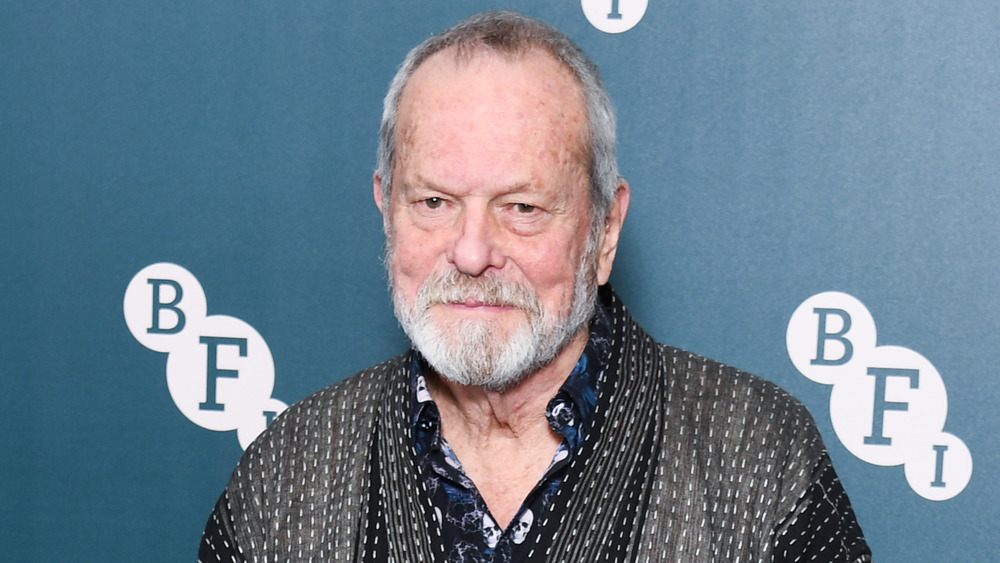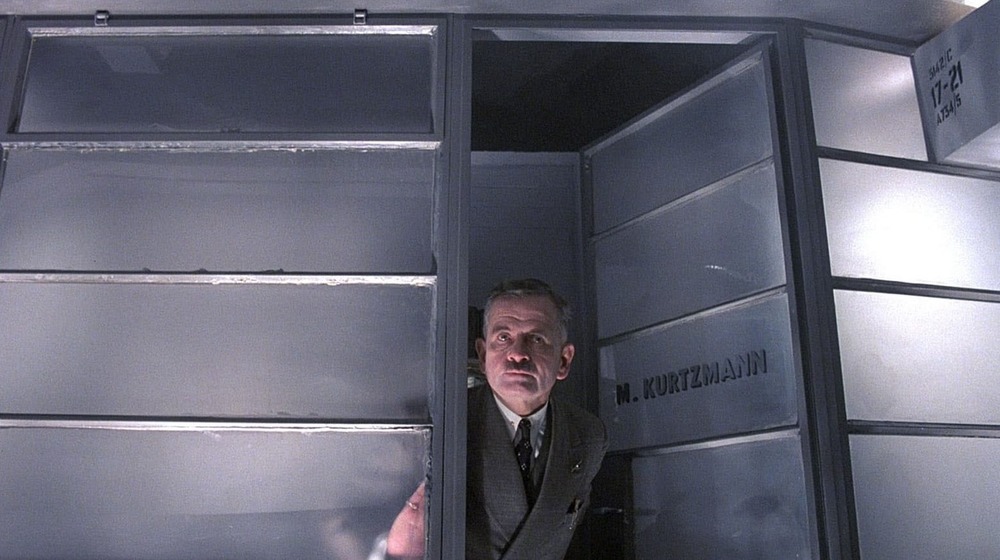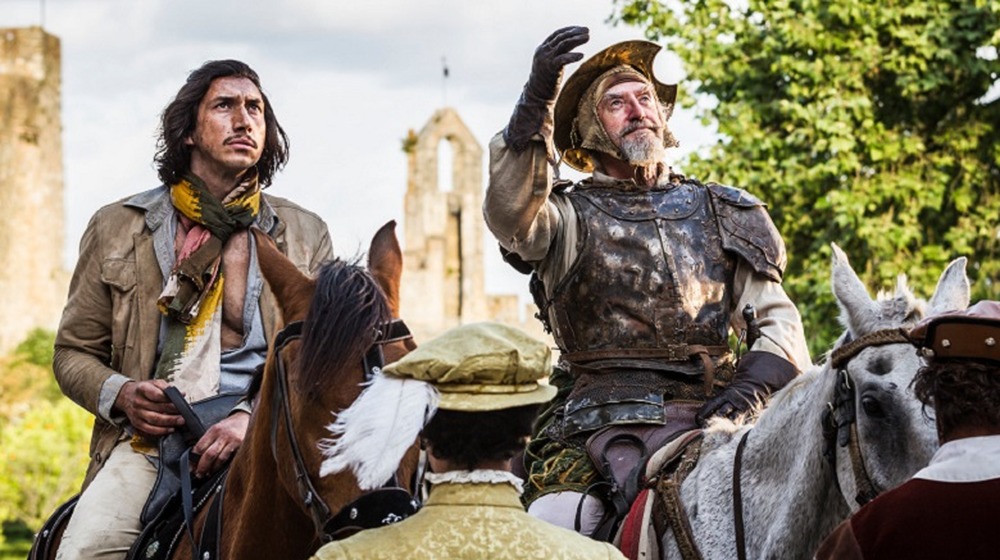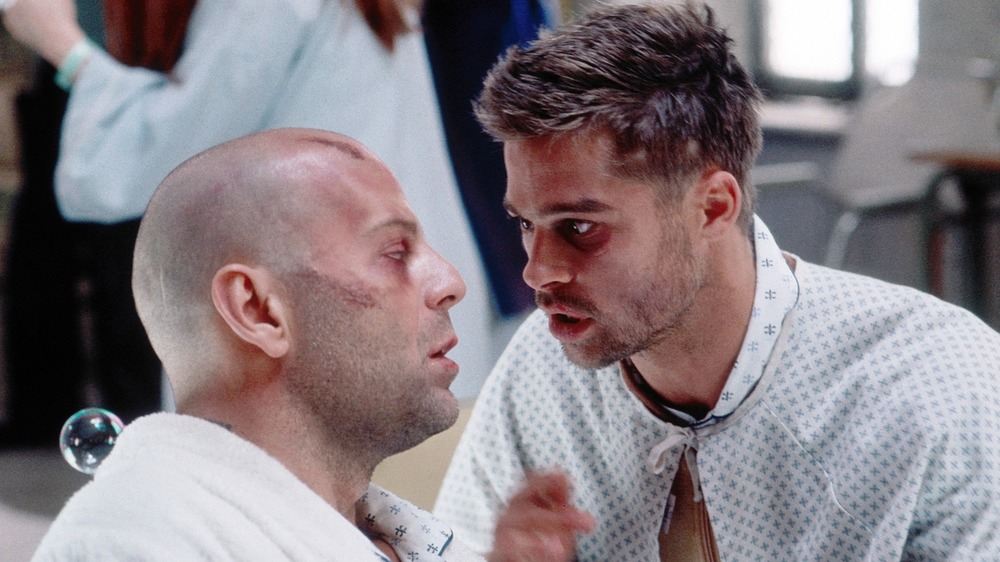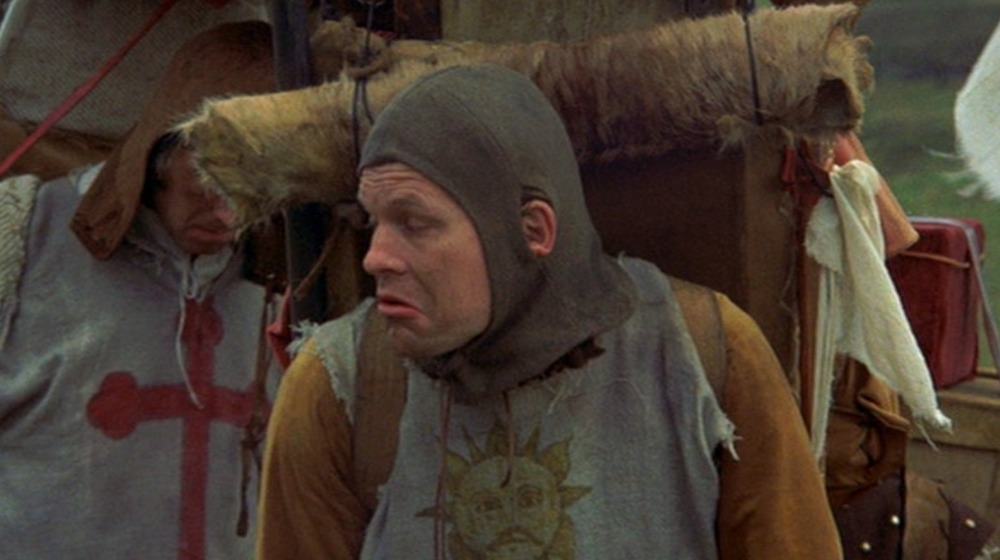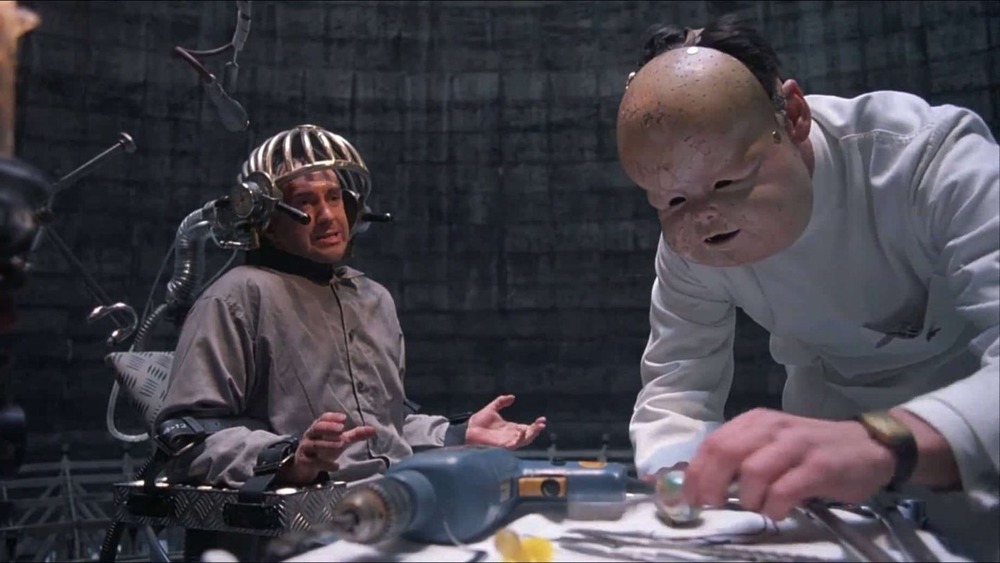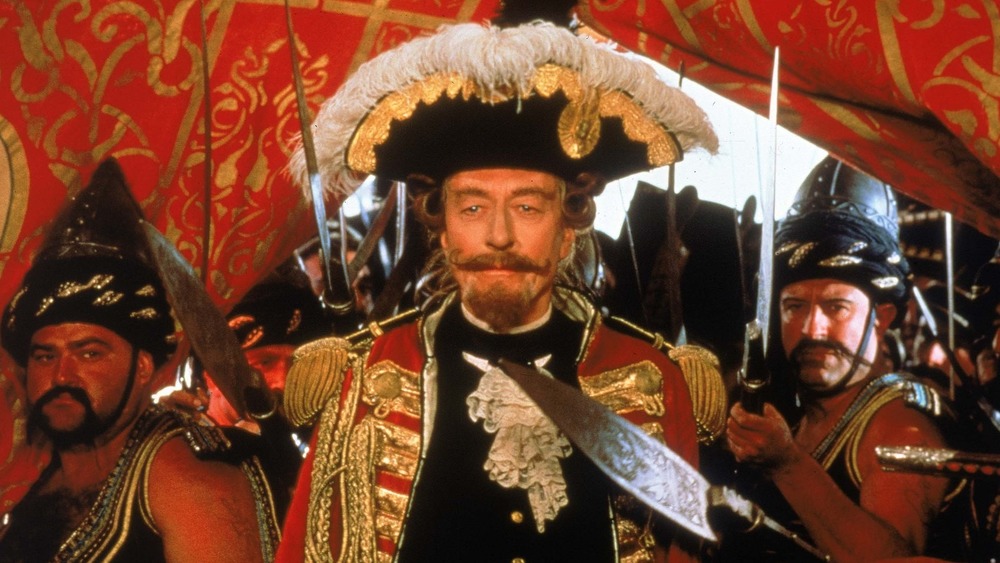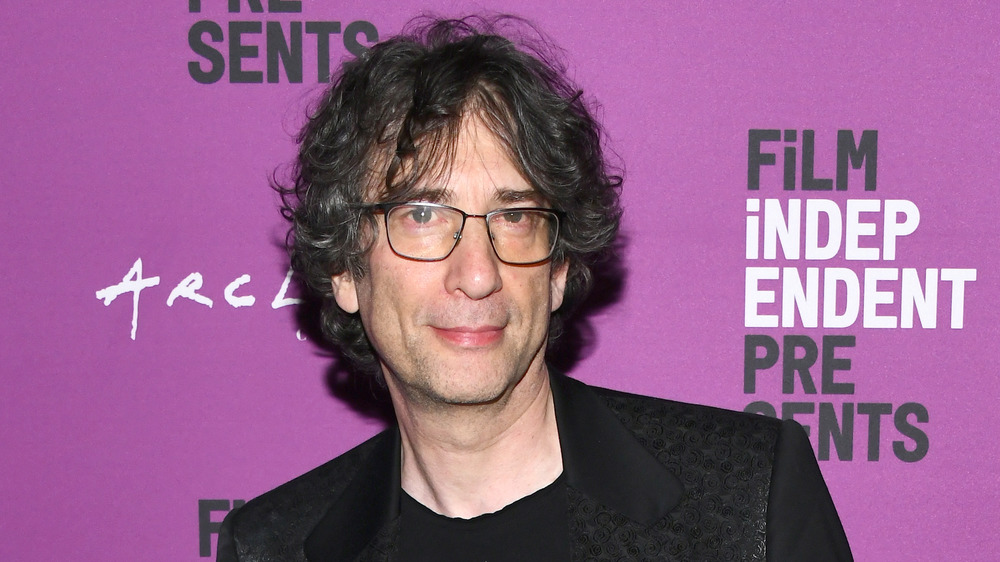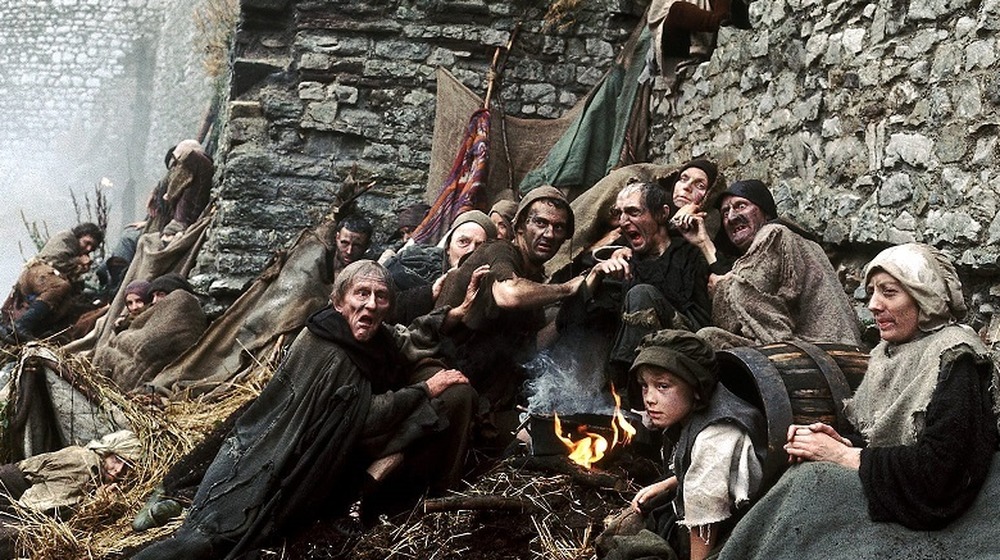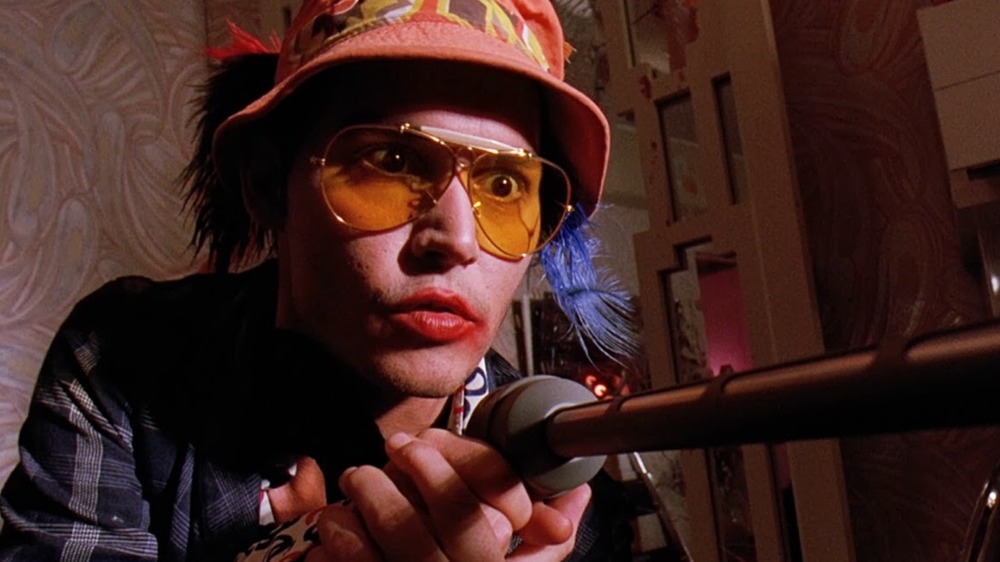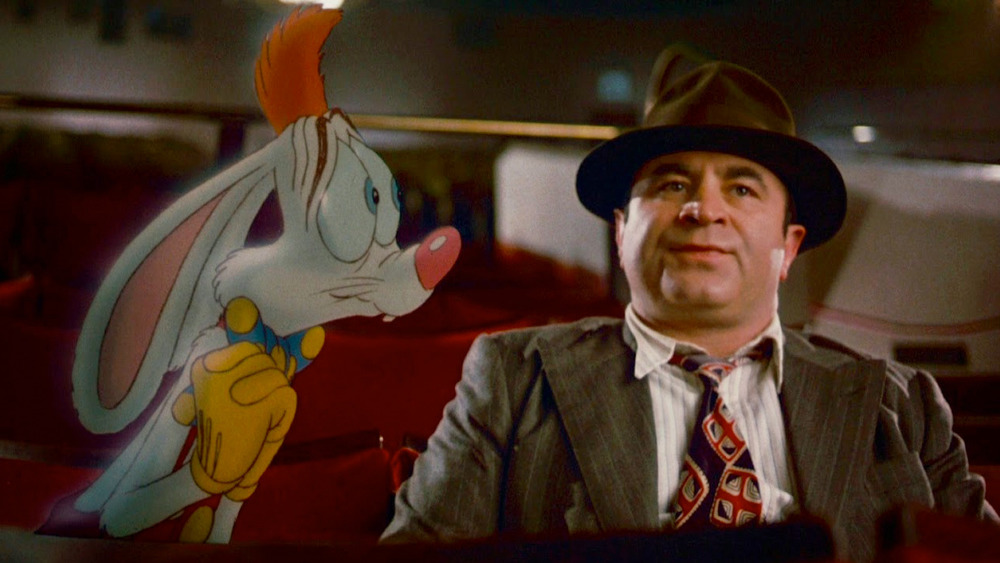The Untold Truth Of Terry Gilliam
Terry Gilliam has had a unique journey as an artist. At various points, he's been a cartoonist, an animator, a comedy writer, an actor, and is now best known for being a director. It can be argued that he's almost exclusively made films with a fantasy bent, yet his films are so quirky that it's hard to group them in with standard fantasy fare. Gilliam has a singular vision for his work that's often been at odds with his studios, but he has always fought doggedly to preserve his ideas.
From his career with Monty Python to classic films like Brazil and 12 Monkeys, Gilliam's fascination with the cracks in both society and reality and how they relate to our sense of sanity has been a constant running theme. If the lasting image from his Monty Python animations is a foot coming down to smash everything else, his movies reflect that in the way that dreamers are similarly punished for daring to dream. At the same time, Gilliam's movies argue that pursuing dreams is the only valuable use of our time we have as humans.
It's a theme that he lives on a daily basis, as he relentlessly kept at failed projects like The Man Who Killed Don Quixote until he was finally able to complete them or take on seemingly unfilmable books like Hunter S. Thompson's Fear And Loathing In Las Vegas. Let's take a look at how he's translated his vision onto film.
Working For Mr. Kurtzman
Like many who grew up in 1950s America, Terry Gilliam was obsessed with the subversive humor of MAD magazine. At the time of its publication, it was a revolutionary comic book, because the brand of snarky, anti-establishment humor that editor Harvey Kurtzman employed had never been aimed at children. After graduating from college in the early 1960s, Gilliam went off to New York in the hopes of getting a job with Kurtzman, who had started a new humor publication called Help!
As luck would have it, Kurtzman's editorial assistant Chuck Alverson had just quit. (Gilliam would go on to co-write Jabberwocky with him.) Alverson had replaced one Gloria Steinem in that role. Help! launched the careers of many underground cartoonists, including Robert Crumb, Gilbert Shelton, and Skip Williamson. While these and other great cartoonists like former MAD artists Will Elder and Al Jaffee contributed to Help!, Kurtzman also included what would later become a popular form of sequential art: fumetti. Based on the Italian word for "comics," fumetti are comics that feature a series of staged photographs with word balloons instead of drawings. It was Gilliam's job to wrangle actors and find locations for the fumetti; he noted, "I was basically out there making films." Help! #24 featured a fumetti starring one John Cleese.
Years later, Gilliam would name Sam Lowry's kindly boss in Brazil Mr. Kurtzman, in honor of his mentor.
Lost In La Mancha
The Merriam-Webster dictionary defines quixotic as "foolishly impractical, especially in the pursuit of ideals." It made sense that Terry Gilliam's adaptation of the classic Miguel de Cervantes novel Don Quixote would be one of the most quixotic film shoots of all time. He first started to make The Man Who Killed Don Quixote in 2000 with Johnny Depp. However, a series of bizarre occurrences disrupted his set. Military fly-overs from F-16s disrupted recording, storms that produced floods washed away his sets, and star Jean Rochefort had to be air-lifted to a hospital due to a hernia. All of this was chronicled in the 2002 documentary Lost In La Mancha, which was originally supposed to be a "making-of" feature but instead detailed what derailed the film.
Production was supposed to resume in 2008 after he got the rights back to the source material but stalled out again. The film finally debuted in 2019 with Jonathan Pryce in the "Don Quixote" role and Adam Driver as Toby, a filmmaker trying to make a commercial using the Don Quixote and Sancho Panza characters. A decade earlier, Toby had made a student film called The Man Who Killed Don Quixote with Pryce's character Javier playing the hero. Along the way, Javier became convinced that he's Don Quixote and embarked on whimsical adventures with Toby. It's no wonder that a film so meta should wind up nearly eating its own metaphorical tail in production; its debut was delayed by lawsuits!
12 Monkeys And La Jette
In 1962, a French filmmaker named Chris Marker wrote and directed a short film titled La Jetée. Other than a very brief scene, the entire film was presented as a series of still photographs with a narrator piecing the action together. It's about a man in a post-apocalyptic society who was sent back in time, in part, because there's a strong childhood memory he held of being at an airport and seeing a man die. The still photo technique was reflective of the nature of memory, holding flashes of images from years earlier while sometimes being unable to piece it all together.
In 1995, Gilliam released 12 Monkeys, a film inspired by La Jetée. He and the screenwriters took the basic plot and not only expanded it, but fused it with his grimy aesthetic and blended in themes of technology as a malignant presence and the fragility of sanity. Star Bruce Willis was sent back in time by a cabal of sinister scientists in order to determine how the apocalypse happened. The only clue they had was that it had something to do with "the army of the 12 monkeys," but that proved to be a red herring. The scientists often sent him to the wrong time, and every trip back may have affected his sanity.
If La Jetée's brilliance was in its simplicity, then 12 Monkeys' success was in Gilliam's willingness to go big, broad, and ugly.
Python Days
After Help! folded, Gilliam left America and went to England. John Cleese was now working regularly on TV and Gilliam wanted in. He eventually got a gig doing animations for a kids' show called Do Not Adjust Your Set, working with Michael Palin, Eric Idle, and Terry Jones. When those three, Cleese, and Graham Chapman formed the sketch group Monty Python and starred in the show Monty Python's Flying Circus, Gilliam signed on to do the bizarre animations that linked sketches before becoming a full member. One of the best was Spiny Norman, the giant hedgehog that crime boss Dinsdale Piranha claimed was following him around London.
As the Pythons expanded into other media, Gilliam handled the graphic design duties. That included The Big Red Book and The Brand New Monty Python Bok (also released in "papperbok"), as well as the album covers for their records like The Monty Python Matching Tie And Handkerchief. Gilliam brought a surreal, underground comics flavor to the Python's blend of silliness and subversion.
Gilliam also played bit parts in both the sketches and the movies. He played King Arthur's "horse" Patsy and the Old Man From Scene 24 in Monty Python And The Holy Grail. He was Cardinal Fang in the famous "Spanish Inquisition" sketch.
Gilliam cut his teeth directing with the Pythons as well, directing photography in Monty Python And The Holy Grail as well as the "invasive short" The Crimson Permanent Assurance in Monty Python's Meaning Of Life.
The Battle For Brazil
Brazil was released in 1985, but Universal Films almost didn't release it all in the U.S. This film — about an everyman in a dystopian, corporate society where constantly breaking machines ran everything and everyday life was choked by soulless bureaucracy — was nearly held back by an entertainment conglomerate whose chief executive thought the movie was too depressing. The title referred to the fantasy of there being a better world out there, which led to the false ending where the hero seemed to be rescued and lived happily ever after with the girl. That's the ending that the studio wanted, as they also wanted to excise the dream sequences that were crucial to the hero's psyche.
Gilliam went on the offensive, showing his cut of the film to critics across the border in Mexico and even in Europe, as Universal had forbidden this cut to be shown anywhere in the U.S. Critics in Los Angeles started to organize secret screenings of the film, and when the LA Film Critics Association awarded it Best Picture and Gilliam Best Director, it turned the tide. So did a full-page ad that Gilliam took out in Variety, asking studio executive Sidney Sheinberg when he was going to release his film. In the end, Gilliam got his way, and Brazil's mix of bleak, absurdist humor and pointed social commentary made it one of his most critically acclaimed films.
Three Is The Magic Number
Gilliam grouped a number of his films into loose, thematic trilogies. Time Bandits, Brazil, and The Adventures Of Baron Munchausen made up the "trilogy of imagination," as each of the films was about trying to escape a world that was nightmarish or worse: boring and regimented. Time Bandits was an adventure told from the point of view of a child, Brazil from an adult trying to find his way in the world, and The Adventures Of Baron Munchausen from an old man. The first film featured the death of innocence, the second a harsh reminder that it's impossible to escape the real world, and the third opened up the possibility of imagination when you've let everything else go.
His second loose trilogy consisted of The Fisher King, 12 Monkeys, and Fear And Loathing In Las Vegas: the "Americana" trilogy. These were all adaptations of other media that he didn't write, but there were all magical realist explorations of America. Each focused on a uniquely American city: New York, Philadelphia, and Las Vegas, respectively. Each film explored the relationship between fantasy and insanity and how trauma can break people. Each was also a quest film, where the heroes of each film met with mixed results.
The Brothers Grimm, Tideland, and The Imaginarium of Doctor Parnassus could also be grouped as a loose trilogy. Every film is about fantasy as deception, and the price that must be paid for this deception.
Films That Never Were
While Gilliam finally did get to make The Man Who Killed Don Quixote, he's also had plenty of projects that never got off the ground. As a fan of dystopian political fantasy, it's not surprising that he was interested in adapting Alan Moore and Dave Gibbons' comic Watchmen. Producer Joel Silver wanted to pursue it, especially after the success of 1989's Batman, but money was an issue. Names like Robin Williams and Arnold Schwarzenegger were floated for the film. It was noted that the end of the Cold War made its themes less relevant. Gilliam gave it another crack in 1986, but to no avail.
Another big miss for Gilliam was not being offered Harry Potter And The Philosopher's Stone. Reportedly the first choice of J.K. Rowling and the film's producer, Gilliam said that "Then wiser people — studio heads — prevailed." Gilliam hated Chris Columbus' adaptation of the novels saying they were "...terrible. Just dull. Pedestrian."
In the early 2000s, Gilliam tried to adapt Terry Pratchett and Neil Gaiman's novel Good Omens; he had Johnny Depp and Robin Williams in mind as its stars. Gilliam said that in the wake of 9/11, the idea was scuttled; no one wanted to do a hilarious movie about the apocalypse. Even years later, Gilliam was still hoping to make it before it was adapted as a miniseries for Amazon.
The Defective Detective was a project Gilliam conceived in 1992, but it was always passed over in favor of other projects.
Grime Time
Jabberwocky was Gilliam's first solo directorial effort. He noted that Italian film director Pier Paolo Pasolini was an influence on its visceral style, saying "I could smell and feel his worlds. That was what I wanted to achieve." The dirt, grime, and clutter of Jabberwocky and many of Gilliam's other films is one of the signatures of his visual style.
12 Monkeys' grimy future, where the survivors of the apocalypse lived underground, was particularly heightened when Bruce Willis went to the past and was delighted at being able to breathe clean air. Brazil was marked by the drab, gray buildings and apartments crammed with ducts that constantly broke down. The heroes of Time Bandits were caked in dirt. Robin Williams' hero in The Fisher King was dressed in rags.
The fantasy elements in his films often worked as a counterpoint to the drabness of everyday life they depicted. Gilliam noted in an interview, "I've always liked the idea that film is an artifice, and that this is admitted right from the start. So we create a world that isn't true to a realistic naturalistic world, but is truthful. I think it also comes from being a cartoonist. I've always abstracted. Cartoons always push toward the grotesque. You twist, you bend, you shape."
To achieve this vision, Gilliam used a lot of low and high-angle shots, as well as a wide-angled lens in order to create more distortion. Fear And Loathing In Las Vegas made extensive use of it.
Fear And Loathing And Doctor Thompson
Fear And Loathing In Las Vegas was an unusual project even for Gilliam. An adaption of famed gonzo journalist Dr. Hunter S. Thompson's psychedelic travelogue and scathing critique of America, Gilliam was not the first director attached. Thompson and star Johnny Depp worked closely together, but Thompson hated director Alex Cox's idea of animating portions of the film and fired him. Gilliam was not only a fan of Thompson's book, he was also close friends with Ralph Steadman, who had illustrated the book, and Steadman had been urging him to adapt it for years.
Thompson not only gave Depp all of the original clothes he wore on the trip, but even loaned him the famous red convertible that made the trip into Vegas.
Thompson made a brief cameo in the film, and he made filming it an adventure. Gilliam noted that Thompson needed to be the center of attention, "throwing bread rolls everywhere while we were filming." It took setting him up with the best-looking extra for him to settle down.
The film was hated at the Cannes Film Festival and did not make back its $18,000,000 budget. However, Gilliam has relished its current position as a cult classic.
Fantasy Booking
Many of Gilliam's projects just never materialized. For example, Stanley Kubrick wanted Gilliam to direct a sequel to Dr. Strangelove called Son Of Strangelove. Gilliam only found out after Kubrick had died, when notes to that effect were found among screenwriter Terry Southern's papers after his death. Gilliam was trying to direct an unfinished script that Kubrick abandoned called Lunatic At Large before the worldwide COVID-19 lockdown halted things.
Gilliam also turned down a number of films. A notable one was Who Framed Roger Rabbit, which was a big hit and won four Academy Awards. Gilliam turned it down when it was still in book form, because he didn't want to get back into animation. "I just read the book and said, 'This is too much work.' Pure laziness on my part.'"
Another big name on that list of films he turned down was Braveheart. He and Mel Gibson were working together on an adaptation of Charles Dickens' A Tale Of Two Cities, but Gibson not only decided to do Braveheart instead, he also decided to direct it himself after Gilliam declined. Then the other movie fell apart when Gibson walked away.
Gilliam also turned down Forrest Gump, Enemy Mine, and an unnamed Alien sequel. He turned down the latter because he didn't want to do a "factory job."
